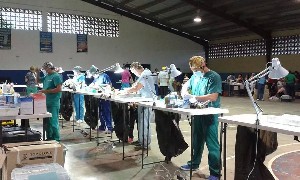A Sustainable Solution to Animal Overpopulation

“Ending is better than mending.” Aldous Huxley, A Brave New World When we talk about sustainable change in countries and communities we are speaking about changing mindsets as an approach to solving problems. Spay Panama is one such organization that uses a sustainable approach to solving the over-population problem of dogs and cats. By providing low cost sterilizations, they help low-income owners reach their goal, and by promoting responsible animal ownership and education, they strive to solve the problem at the root. Animal overpopulation is a common problem in developing countries where free roaming animals are a symptom of an increase in human population, poor waste disposal management, and an absence of responsible animal ownership values. To deal with the issue in Panama, Patricia (Pat) Chan created Spay Panama in 2001. Speaking by phone, from an on-site spay and neuter clinic in Bethania, Pat said: “When we started in 2001, we had two vets who agreed to do low cost operations and we began by doing spays and neuters on Sundays at a clinic that was on loan”.
The Sunday spay clinics saw long lineups that spoke to a real need for animal control. In the months to come, it would become apparent that Spay Panama would need a facility of their own. Before long they were operating 5 days a week. The spay clinic in Panama City was preforming sterilizations on many animals everyday. However there were many more in animals in the interior that were not getting attention. To deal with communities that had an animal over-population problem Spay Panama mobilized, taking vets, tables, and equipment on the road to set up travelling clinics.
From the beginning, Pat Chan’s belief rests in the philosophy that a co-operative effort is needed to solve the problem. "You have to empower a community to care about their animals. If we go in and operate, we haven’t fixed the problem. The community needs to take responsibility and be involved”.
Being involved means that community members must provide a clean space to preform operations. They must also provide volunteers for the clinic and clean up afterwards among other duties. People bringing their animals in for operations must pay a donation, no matter how small. “There was this one boy who brought a dog and didn’t have any money at all. I asked him to go pick up 20 pieces of garbage from the street and deposit it in the can here. I accepted that as his donation”. “People have to contribute to the care of their animals.” Says Pat.
Promoting animal responsibility also takes Spay Panama into schools in rural areas. “We ask kids what do you need to live happily, and they say ‘air’, ‘water’, ‘food’, ‘love’. Then we show them how the dogs and cats around them need the same.
Pat is a firm believer in dealing with the root of the problem. She does not believe in animal shelters. “Shelters have the best intention, but the scenario is not something that can be maintained. Shelters promote zero responsibility. They teach people that it is ok to dump their unwanted animals".
Today, 14 years later, Spay Panama has sterilized 93,000 dogs and cats. The non-profit organization is run largely by donations with little help from government. That situation, however is already seeing changes, as Panama take steps towards the humane treatment of animals.
Recently Panama passed Law 70, a law that grants animals rights. In accordance with the law, owners must provide food and water, along with sufficient room to rest and defecate. Panama is also one of the countries that has signed the Universal Declaration on Animal Welfare, which recognizes that animal feel pain and that animal cruelty and suffering is an urgent global issue.
Recently Spay Panama signed an agreement of co-operation with José Isabel Blandón, the Mayor of Panama City to help subsidize the spay and neuter of 9400 animals. “The city will help, but the animal guardian also has to contribute”, says Pat to stress the importance of responsibility.
In 2006 Dr. Isis Johnston Brown, came to Panama to train Spay Panama vets on a quick spay and release method. The technique changed things for Spay Panama. Before that they were holding certain animals for several days before release and were running into problems of being able to sustain the effort. The new method revolutionized the way the organization worked. They were now able to sterilize more animals as they could be released the same day.
In fact, Spay Panama has taken a huge lead in the field of low cost animal birth control. Through partnerships with Spay USA, The Humane Society and other animal welfare organizations, Spay Panama has taken vets to other countries to help set up spay initiatives. They also serve as a training ground for vets who come to Panama from other organizations to learn and practice the QuickSpay method. Today Spay Panama has a base of 8 full time vets and about 100 volunteers across Panama.
I asked Pat how she felt to see the success of her efforts. “We still have a long way to go”, she said, "but I feel we are getting somewhere”.
And on the topic of local efforts by other groups like Spay the Stays that also do spay and neuter clinics? “Everything helps towards the end goal. Do as much as you can”, says Pat.
Trending Tags
